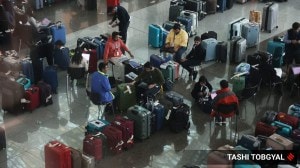The fright and the wrong
Anxiety is contagious. In bad times, why is India importing the West’s worst fears? q

That the global financial markets are seeing their worst-ever turmoil, and that the developed world is heading for recession, is beyond any argument. What is questionable, however, is the way we in India have bought other people’s bad news. Sure enough, we live in a globalised world where ill winds blow as seamlessly across borders as the good tidings about booms. But there are essential differences in our situation. Our stock markets have been hit too, particularly with the FIIs wanting to pull money out (mostly at a great loss) to repay, at least partly, the leveraged (borrowed) money they had brought in to invest. That pressure, to take money out, has also resulted in an unusually large demand for dollars, thereby weakening the rupee.
Now, anybody with anything to do with the economy or the markets knows all this. But this is not a pink paper, so we can go ahead and state the obvious. Further, do the readers of pink papers and watchers of business channels really know? Because, if they did, would they still be doing what they are doing right now, fleeing in fright of an enemy still unseen, like the Indian army against the Chinese in 1962?
I am sorry to drag military history into what is, after all, an argument on the markets. But human character, emotion, strength and weakness are all tested in extreme situations like a war, or a market bust of this magnitude. Panic and fear are the most primordial of human emotions and you can expect people to act the same way, whether facing an armed enemy, or the prospect of financial rout. The biggest fear, of course, is the fear of the unknown, and it is the most infectious of all.
I was given a night-long tutorial once on courage and fear by General Sundarji while we were together on a track-II conference in Salzburg in the summer of 1994. Fear and courage, he said, are the most infectious of all viruses. In times of great stress or anxiety, or under threat, human beings look at the next guy and make up their minds entirely on the basis of what they read on his face. He cited the example of his own regiment, the Mahars, in the 1947-48 Kashmir campaign against the Pakistani raiders. One platoon from his regiment fled in great confusion even before they had come under attack. Another, on the very next hill feature, put up a brilliant defence against a much stronger and numerous enemy, and even after the senior havildar leading it had been killed early on. An inquiry was held later. The platoon that ran away just saw one man turn tail, fear on his face, and everybody just followed. The one that fought so valiantly saw their havildar charge at the attackers with an automatic weapon. A raider came from behind and decapitated him with his sword but even as his body slumped, the automatic fired a couple more bursts. So word went around, unspoken — but everybody knew it — that a fellow Mahar was charging the enemy even after having been beheaded. So everybody just hunkered down and fought, to win.
I remember that story each day looking at the faces of business channel anchors, of the experts, fund managers, analysts who give us their “take” — usually now on whether they think this is the “bottom”. You only hear them talk of sentiment, of the global disaster and how nothing is ever going to mitigate it and, most touchingly, of how they have never seen such a thing before. Then the same experts and fund managers go and dump more shares in panic and, looking at them, so do the smaller investors, much like Sundarji’s platoon on the first hill feature. When the market was going up, hardly any of us were ever warned that it was defying logic, gravity and, that oft-misused term, “fundamentals”. Today, if you have seen anybody of consequence on business channels saying that it is stupid to dump your shares at these valuations, that the levels to which values have fallen defy “fundamentals”, please name him and he will be a good candidate for Republic Day honours. Markets are driven by sentiment, alright, but does logic have no place there? Probably it doesn’t. Because the same business papers and channels which are spreading so much gloom and doom now were producing front pages bristling with sparklers and balloons each time the Sensex climbed another peak, or were presenting their anchors in dunce caps and shirts with new Sensex numbers printed on them. OK, the story has reversed now, so must you shoot the messenger, you may ask. Good question, but must we get so sentiment-driven that we take leave of logic and facts entirely?
Somebody has to ask what happened overnight between Thursday and Friday that justified a fine company like Hindalco losing 25 per cent of its value. We know commodities are all in bad odour now. But this company raised Rs 5,000 crore in a rights issue just a week ago. What is to justify it being valued at just around Rs 6,000 crore today? And real estate, yes, it was a bubble that needed to burst, it had to pay for its excesses. But for Unitech to lose 52 per cent value in one day? Or, again, we know that crude is falling, but for a solid, sarkari, almost sovereign-protected company like ONGC to fall 15 per cent in one day? This is not logic or sentiment. This is pure panic and madness. The FIIs have their own problems. The world has come crashing down where they come from and they need to take back what is left over of their investments in overseas markets. But must we embrace and internalise a disaster peculiar to them as well, and dump value like this?
The fact that many are doing so only goes to show how the rich have an inability to handle adversity, unlike the jawan or the kisan. I know it is dangerous to be a contrarian in such times. And since the rich, unlike our poorly paid jawans, are also really small in their hearts and some other unmentionable parts of their anatomy, it is unlikely that they are going to be impressed even by somebody like Sundarji’s havildar who inspired such a stirring fightback on a lonely hill in Poonch. It is also not my or this paper’s intention to say buy or sell. We are not a pink paper or a blue channel, and who will take me seriously anyway? But please allow me to flag a few facts. While Singapore and the UK have reported a small contraction and the US is headed that way, the most, most pessimistic prediction on this year’s growth in India is 6.5 per cent, only the second behind China, although a very conservative RBI still says 7.7. You call that recession? Normally, it would be a boom year. But we are so spoilt by four years of 9 per cent and so terrified looking at the slide in Western economies that we have misread a slowdown for recession.
And we are not a small economy. Exports are only 13 per cent of our GDP and while some will suffer due to a global recession, some sectors will benefit hugely from a weaker rupee. There is an enormous domestic demand for goods and services and hundreds of billions worth of infrastructure to build. Yes, capital will be scarce, but why don’t we also factor in the cost reduction because of crashing commodity prices? Because of falling crude prices, the government could save Rs 100,000 crore this year alone on fuel and fertiliser subsidies; going ahead it could be two and a half times as much. Over the next few weeks, we see inflation falling drastically, a cut in fuel prices, a drop in interest rates and the release of Pay Commission arrears. Households in India are heading for a much better year compared to the last couple, though of course those invested in stocks would rue the loss of their net worth. You are still looking at an economy on the up, and one that is uniquely positioned to fight back, and take advantage of this global crisis. But, for that, something has to inspire us to hunker down with confident stoicism, and fight back, much like Sundarji’s platoon on that second hill feature.
sgexpressindia.com
- 01
- 02
- 03
- 04
- 05































